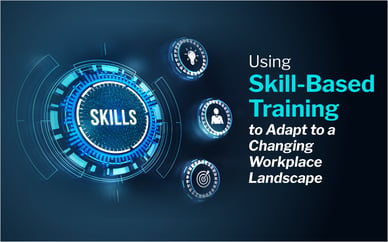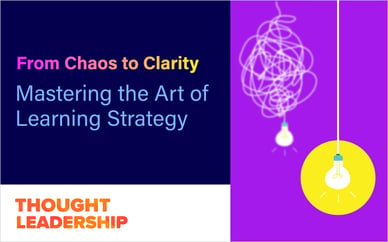
A new year, a new decade, a new beginning. 2020 is all of these things. With this new year in full swing, it’s time to shake up your learning program. Right now you are probably working on planning out what your organization’s training program will look like for this new year.
Wouldn’t it be nice to take this opportunity to apply something new to your program in this fresh year?
Sure it would! But what should this look like?
Well, you're in luck, we’ve got your back.
Let’s take a look at 5 trends we see being big this year.
Hopefully you’ll see something that inspires you and gives you a fresh idea to rock your organization’s training program this year.
1. Learning will become more immersive
Immersive learning leverages virtual and augmented reality technology to take learners out from in front of the screen of a traditional eLearning course and put them directly into the scenario you are training them to encounter. Through virtual reality, you can set up a difficult scenario where your learners’ actions and emotions are tested in real time. It’s learning by doing in the most complete sense, but with the safety to try and fail in any given scenario.
Good news—technology in this area has evolved dramatically and become more economically feasible than ever before and will continue to do so as time progresses.
“This is a technology that is much further along than most people think it is. It is absolutely ready for prime time. I still vividly remember the entire experience end to end. I’ve been through a lot of training programs, and I don’t remember any of the other ones. It’s very, very effective.”
- Josh Bersin, President and founder of Bersin and Associates.
Learning by doing through immersive scenarios aids in retention and recall when the learner faces the situation in the real world. Many organizations have begun to utilize virtual reality to train in areas such customer service, safety, and interviewing skills.
2. Learning will become more personal
Every learner is unique and faces various different needs along their career path. Your company’s one size fits all approach to training is not going to be effective for most of your learners. Think about this, if you are training a learner on something they know how to do proficiently, you might be wasting company time and money retraining them on it.
“One size doesn’t fit all. It doesn’t work for clothes and it doesn’t work for learning in the workplace. Personalized and adaptive learning allows for people to choose their learning paths and in doing so, they are more motivated to learn and progress.”
- Shannon Tipton, Learning Rebels
Consider applying an adaptive learning model. Allowing learners to test out of retaking content for information they already know and focusing them on what knowledge they are missing or need to work on will maximize the use of their time and save on company resources.
Additionally, allowing learners to set their own personal development goals and create their own learner personalized learning path with increase their satisfaction at work, which increases employee retention. Artificial intelligence and Learning Experience Platforms can also be utilized to help learners identify where they should focus and help set learning paths.
3. Shorter, more engaging content will prevail
Let’s face it, learners’ attention spans just aren’t what they used to be. No one has the time to sit down and go through an hour long course. They’re busy. They have work to do. They want their training to be short and engaging so they can get what they need and get back to work.
Microlearning courses have been on the rise for a while now. These short courses get right to what the learner needs to know, including only the most crucial information. The short nature of microlearning courses also allow them to be accessed at the time of need. For example, if the learner needs to review some information while trying to complete an assigned task, they can quickly review a microlearning module.
“Short, focused and fun learning should become the focus of all learning professionals going forward. This is a much more efficient way of delivering learning and also ensuring the engagement of your learners.”
- Phil Mayor, eLearning Laboratory
Video content is another powerful tool that can be deployed to make training more engaging. Short videos help the learner stay focused and understand key information, rather than trying to retain all the information from a long block of copy.
Additionally, mobile technology allows learners to access training wherever they are. They no longer have to be tethered to their desk to consume training content. It can be completed on the go from the palm of their hand.
4. Soft skills will become key
Soft skills have been found to be among the most sought after skills for employees. An employee’s ability to think creatively, work well with others, and apply leadership techniques builds them into a well rounded and more effective employee.
Studies have found that 75% of long term career success comes from mastery of soft skills.
Providing content that helps employees develop these skills will be crucial to your organization’s future. Keep in mind that developing these skills won’t happen in one sitting. Provide opportunities for learners to practice and implement these skills until they master them.
5. Communities will be on the rise
Learning isn’t just an individual experience, learning should be in your company’s culture. Creating a space where everyone has the ability to share knowledge with those they work with opens up a wealth of knowledge and cooperation that builds the culture of learning into your organization’s DNA.
Social learning includes not only sharing information online through social learning platforms, but also collaborative learning through group activities, lunch and learns, and many informal learning opportunities that arise throughout the course of the normal work day.
“Learning is everyone’s domain. Workplace learning must adapt to this new world and provide the tools and vehicles to leverage the collective wisdom in the organization…
Bottom line: We need to help employees connect with other people and information within and across organizations, so they stay engaged and keep up with industry, job, and organizational changes.”
- Inette Dishler, UC Berkeley
Along with providing opportunities for social learning, mentorship provides opportunities for employees to build strong bonds with managers and others within the organization. Working with others with more experience and receiving feedback to improve provide opportunities for personal growth and recognition of skills that may contribute to an employee staying with and moving up in the organization for a good long time.
So there you have it. This is not an exhaustive list of all the new things you could apply in 2020, but we think these are going to be some of the bigger ones.
Let us know what you think.
What other trends do you plan on applying this year? What other trends do you think will be big this year?
Interested in implementing some of these ideas, like microlearning or soft skills focused training? eLearning Brothers can help you out.








